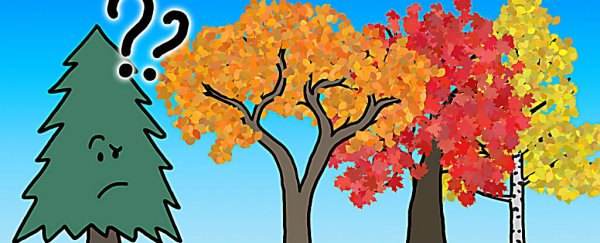Why do autumn leaves change colour? Because they lose the chlorophyll that makes them green, allowing the yellowy-orange pigment to shine through, right? Well, yes, but that's only half the answer, because it doesn't actually explain why they lose that chlorophyll in the first place. As the latest episode of MinuteEarth points out, there has to be a pretty good reason for it, considering these trees end up dropping their leaves over winter anyway. So what's going on here?
As opposed to evergreen trees, which retain their colour all year round, deciduous trees change the colour of their leaves in autumn, and then drop them during winter to avoid the high cost of winterising them. But on the face of it, this doesn't seem to make a whole lot of sense, because dropping all those leaves is like ditching all of the nutrients they just spent months syphoning out of the soil to build those leaves in the first place.
Nature's a whole lot smarter than that though, and the reason they get dressed and undressed every single year is genius. Each fall, a deciduous tree will recycle the nutrients in its leaves before dropping them, so they end up wasting nothing as they weather the frost and snow of the winter months. "That means taking apart cells and photosynthetic apparatus from the inside-out in order to recoup their nitrogen and phosphorous and store it in twigs and branches until next spring," says Henry Reich in the video above.
And here's where the science gets fascinating. While all of the above sounds pretty straightforward, chemistry ensures that it seriously is not. This is because as the tree is disassembling the nutrients, the chlorophyll molecules that absorb sunlight for photosynthesis continue absorbing sunlight as if nothing has changed. But the problem here is because the photosynthesis apparatuses are being broken down, they end up passing the solar energy along to oxygen molecules.
Oxygen molecules might sound pretty innocent, but they become dangerously reactive when energised, says Henry, and if precautions aren't put in place, they will wreak havoc on the parts of the leaves that are in the process of recycling all those precious nutrients. The solution? Trees break down the chlorophyll in their leaves to become less dangerous molecules - typically clear or yellow-hued ones. See? Genius.
Some trees are even more industrious than this when it comes to surviving the harshest months of the year, but I'll let the latest episode of MinuteEarth reveal that brilliant secret. Let's just say that if you're wondering why some trees end up with red and purple leaves in the fall, your question will be answered, and the science is so much cooler than you'd expect.
And if you want to continue this journey we just started, here's MinuteEarth on how trees make it through the winter:
